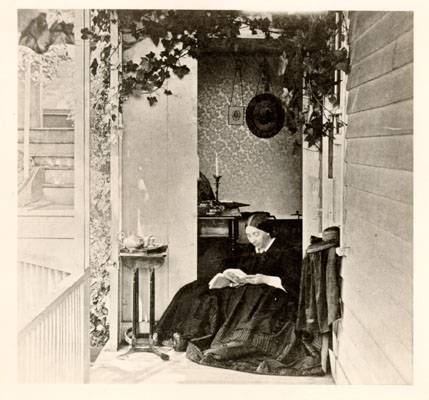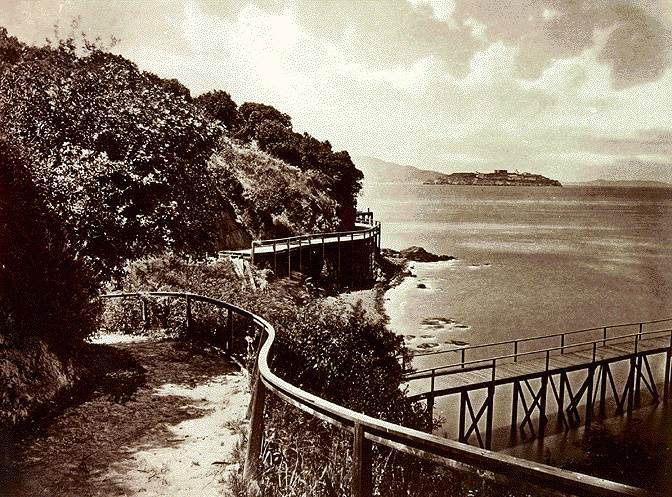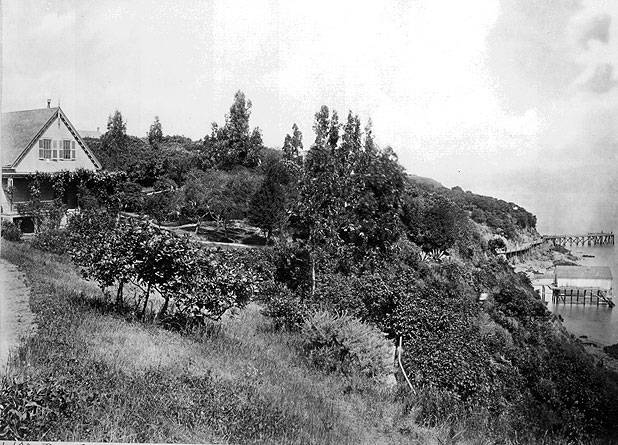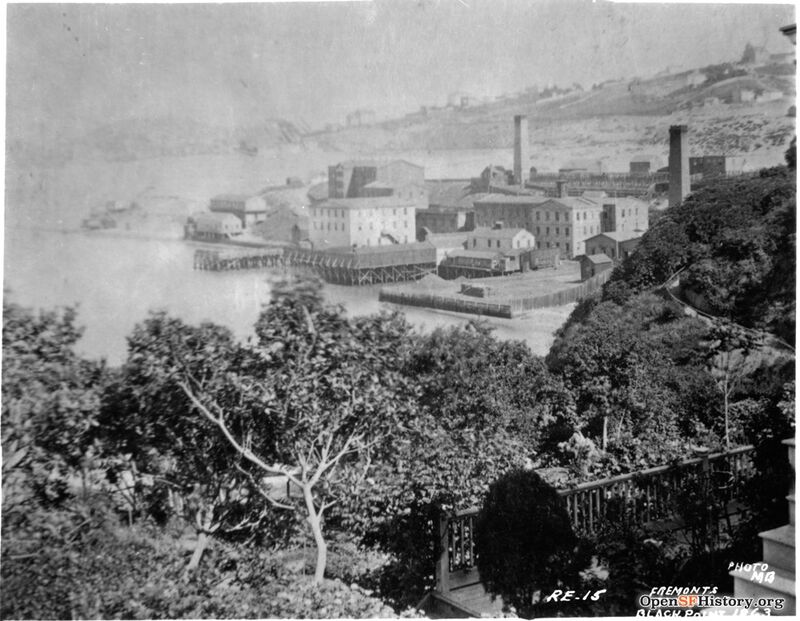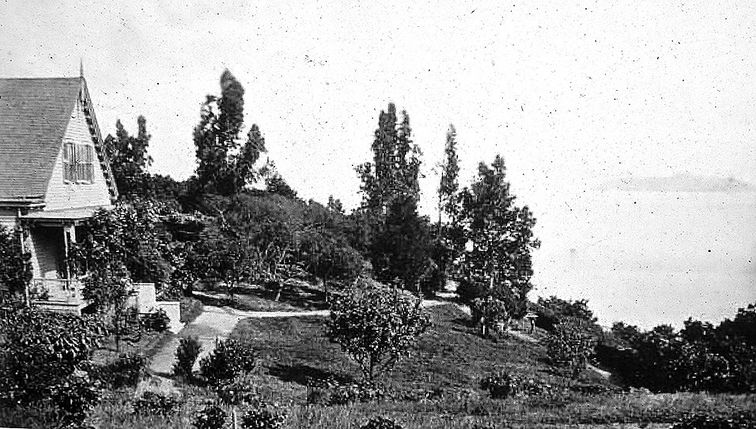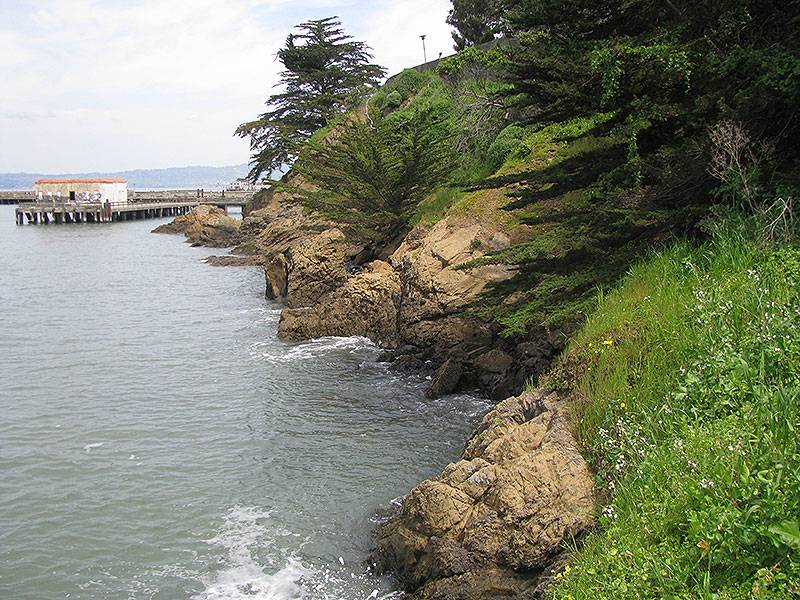Jessie Benton Fremont at Blackpoint: Difference between revisions
changed place in water tour |
No edit summary |
||
| (13 intermediate revisions by 4 users not shown) | |||
| Line 1: | Line 1: | ||
'''<font face = Papyrus> <font color = maroon> <font size = 4>Historical Essay</font></font> </font>''' | '''<font face = Papyrus> <font color = maroon> <font size = 4>Historical Essay</font></font> </font>''' | ||
''by Jo Medrano'' | |||
[[Image:Mrs General Fremont on porch at Black Point 1863 AAC-6063.jpg]] | |||
'''Mrs. General Fremont on porch at Black Point, 1863.''' | |||
''Photo: San Francisco History Center, SF Public Library'' | |||
[[Image:Mrs.-General-Fremont-at-her-home-on-Black-Point-now-Fort-Mason,-about-1863.jpg]] | |||
'''Mrs. General Fremont on her porch at Black Point, c. 1863.''' | |||
''Photo: Jesse Brown Cook collection, [http://www.oac.cdlib.org/view?docId=tf129005j4;developer=local;style=oac4;doc.view=items online archive of California]'' | |||
[[Image:norbeach$black-point-1870.jpg]] | [[Image:norbeach$black-point-1870.jpg]] | ||
''' Black Point (now Fort Mason), 1870. Spring Valley Water Co. brought water through the flume that skirts the cliffs. Small farms run down to the shore. Alcatraz is in the distance.''' | '''Black Point (now Fort Mason), 1870. [[Spring Valley Water Company|Spring Valley Water Co.]] brought water through the flume that skirts the cliffs. Small farms run down to the shore. Alcatraz is in the distance.''' | ||
''Photo: | ''Photo: Private Collection, San Francisco, CA'' | ||
John C. Fremont bought a farm for his wife Jessie on the north edge of San Francisco, on a small rocky peninsula then known as Blackpoint, about 1860. At the time of purchase, they were living in Bear Valley in the Sierras. In Bear Valley Jessie Fremont developed physical problems due to the intense heat. She wrote that a buried egg would cook in just a few minutes. One account states that it was 106 degrees at sunset--not an uncommon temperature that year. So we can probably imagine her delight when John C. came back from a business trip to San Francisco in 1861, and told her they were moving to the city. Blackpoint was a self-sustaining farm, and Jessie's favorite home. She had relatives living with her, as well as visits from other relatives in addition to local and national celebrities. | John C. Fremont bought a farm for his wife Jessie on the north edge of San Francisco, on a small rocky peninsula then known as Blackpoint, about 1860. At the time of purchase, they were living in Bear Valley in the Sierras. In Bear Valley Jessie Fremont developed physical problems due to the intense heat. She wrote that a buried egg would cook in just a few minutes. One account states that it was 106 degrees at sunset--not an uncommon temperature that year. So we can probably imagine her delight when John C. came back from a business trip to San Francisco in 1861, and told her they were moving to the city. Blackpoint was a self-sustaining farm, and Jessie's favorite home. She had relatives living with her, as well as visits from other relatives in addition to local and national celebrities. | ||
| Line 13: | Line 27: | ||
'''Spring Valley Water Company flume is visible at right; Small farms on the hill above c. 1870''' | '''Spring Valley Water Company flume is visible at right; Small farms on the hill above c. 1870''' | ||
''Photo: | ''Photo: Private Collection, San Francisco, CA'' | ||
[[Image:View southeast from Fremonts residence to Pioneer Woolen Mills on site of present Aquatic Park wnp71.1607.jpg|800px]] | |||
'''View southeast from Fremonts' residence to Pioneer Woolen Mills on site of present [[Aquatic Park and Maritime Museum|Aquatic Park]].''' | |||
''Photo: OpenSFHistory.org wnp71.1607'' | |||
As a matter of fact, a influential San Franciscan, I.W. Raymond, visited the Fremonts in Bear Valley and traveled with them to see the place that wasn't yet named Yosemite. He was a key person in the 1864 action of President Lincoln which made Yosemite a protected place. | As a matter of fact, a influential San Franciscan, I.W. Raymond, visited the Fremonts in Bear Valley and traveled with them to see the place that wasn't yet named Yosemite. He was a key person in the 1864 action of President Lincoln which made Yosemite a protected place. | ||
Black Point is described in " | Black Point is described in "Jessie Benton Frémont: A woman who made history" as "a small headland jutting out into the channel entrance of the harbor, in fact directly opposite the Golden Gate, affording an unbroken view westward to the Pacific and eastward toward the mountains of Contra Costa." Jessie said she "loved this sea home so much that I had joy even in the tolling of the fogbell". It was here she planned and built her "sunset beach." | ||
The federal government took over Black Point soon after Jessie and John Fremont went back east to be involved in the civil war. John fought for compensation for the expropriated house and land until the day he died. | The federal government took over Black Point soon after Jessie and John Fremont went back east to be involved in the civil war. John fought for compensation for the expropriated house and land until the day he died. | ||
''-- | [[Image:Black-Point-1869-w-Alcatraz-behind Muybridge.jpg|756px]] | ||
'''Black Point, 1869, Alcatraz in distance.''' | |||
''Photo: Eadweard Muybridge'' | |||
[[Image:Original-shoreline-black-point-2010 6706.jpg]] | |||
'''Original shoreline at Black Point, one of the last places you can see it in San Francisco.''' | |||
''Photo: Chris Carlsson, 2010'' | |||
<hr> | |||
[[Image: | [[Image:Tours-shoreline.gif|link=Nature Reclaims a Piece of the Waterfront]] [[Nature Reclaims a Piece of the Waterfront | Continue Shoreline Tour]] | ||
[[Immigration |Prev. Document]] [[Satty and the "North Beach U-Boat" |Next Document]] | [[Immigration |Prev. Document]] [[Satty and the "North Beach U-Boat" |Next Document]] | ||
[[category:North Beach]] [[category:1860s]] [[category:1870s]] [[category:Military]] [[category:Famous characters]] | [[category:North Beach]] [[category:1860s]] [[category:1870s]] [[category:Military]] [[category:Famous characters]] | ||
Latest revision as of 14:04, 25 March 2022
Historical Essay
by Jo Medrano
Mrs. General Fremont on porch at Black Point, 1863.
Photo: San Francisco History Center, SF Public Library
Mrs. General Fremont on her porch at Black Point, c. 1863.
Photo: Jesse Brown Cook collection, online archive of California
Black Point (now Fort Mason), 1870. Spring Valley Water Co. brought water through the flume that skirts the cliffs. Small farms run down to the shore. Alcatraz is in the distance.
Photo: Private Collection, San Francisco, CA
John C. Fremont bought a farm for his wife Jessie on the north edge of San Francisco, on a small rocky peninsula then known as Blackpoint, about 1860. At the time of purchase, they were living in Bear Valley in the Sierras. In Bear Valley Jessie Fremont developed physical problems due to the intense heat. She wrote that a buried egg would cook in just a few minutes. One account states that it was 106 degrees at sunset--not an uncommon temperature that year. So we can probably imagine her delight when John C. came back from a business trip to San Francisco in 1861, and told her they were moving to the city. Blackpoint was a self-sustaining farm, and Jessie's favorite home. She had relatives living with her, as well as visits from other relatives in addition to local and national celebrities.
Spring Valley Water Company flume is visible at right; Small farms on the hill above c. 1870
Photo: Private Collection, San Francisco, CA
View southeast from Fremonts' residence to Pioneer Woolen Mills on site of present Aquatic Park.
Photo: OpenSFHistory.org wnp71.1607
As a matter of fact, a influential San Franciscan, I.W. Raymond, visited the Fremonts in Bear Valley and traveled with them to see the place that wasn't yet named Yosemite. He was a key person in the 1864 action of President Lincoln which made Yosemite a protected place.
Black Point is described in "Jessie Benton Frémont: A woman who made history" as "a small headland jutting out into the channel entrance of the harbor, in fact directly opposite the Golden Gate, affording an unbroken view westward to the Pacific and eastward toward the mountains of Contra Costa." Jessie said she "loved this sea home so much that I had joy even in the tolling of the fogbell". It was here she planned and built her "sunset beach."
The federal government took over Black Point soon after Jessie and John Fremont went back east to be involved in the civil war. John fought for compensation for the expropriated house and land until the day he died.
Black Point, 1869, Alcatraz in distance.
Photo: Eadweard Muybridge
Original shoreline at Black Point, one of the last places you can see it in San Francisco.
Photo: Chris Carlsson, 2010

